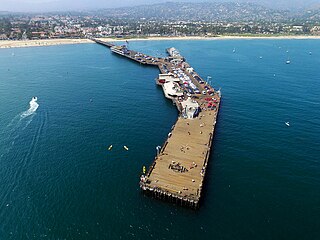
SS Eastland was a passenger ship based in Chicago and used for tours. On 24 July 1915, the ship rolled over onto its side while tied to a dock in the Chicago River. In total, 844 passengers and crew were killed in what was the largest loss of life from a single shipwreck on the Great Lakes.

The Port of Los Angeles is a seaport managed by the Los Angeles Harbor Department, a unit of the City of Los Angeles. It occupies 7,500 acres (3,000 ha) of land and water with 43 miles (69 km) of waterfront and adjoins the separate Port of Long Beach. Promoted as "America's Port", the port is located in San Pedro Bay in the San Pedro and Wilmington neighborhoods of Los Angeles, approximately 20 miles (32 km) south of downtown.
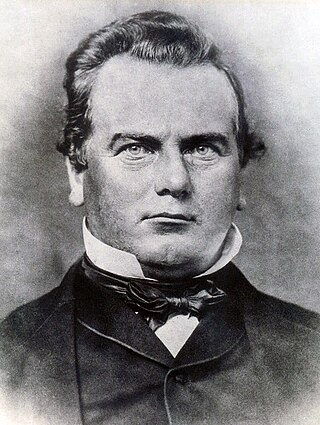
Phineas Banning was an American businessman, financier and entrepreneur.

San Pedro Bay is an inlet on the Pacific Ocean coast of southern California, United States. It is the site of the Port of Los Angeles and the Port of Long Beach, which together form the fifth-busiest port facility in the world and the busiest in the Americas. The Los Angeles community of San Pedro borders a small portion of the western side of the bay, and shares the name. The city of Long Beach borders the port on the eastern side of the bay. The northern part of the bay, which is the largest part of the port, is bordered by the Los Angeles neighborhood of Wilmington.

William Henry Workman was an American politician, banker and businessman. He served two terms as the 18th Mayor of Los Angeles, California.

The Port of San Francisco is a semi-independent organization that oversees the port facilities at San Francisco, California, United States. It is run by a five-member commission, appointed by the Mayor and approved by the Board of Supervisors. The Port is responsible for managing the larger waterfront area that extends from the anchorage of the Golden Gate Bridge, along the Marina district, all the way around the north and east shores of the city of San Francisco including Fisherman's Wharf and the Embarcadero, and southward to the city line just beyond Candlestick Point. In 1968, the State of California, via the California State Lands Commission for the State-operated San Francisco Port Authority, transferred its responsibilities for the Harbor of San Francisco waterfront to the City and County of San Francisco / San Francisco Harbor Commission through the Burton Act AB2649. All eligible State port authority employees had the option to become employees of the City and County of San Francisco to maintain consistent operation of the Port of San Francisco.

David W. Alexander was an early California politician and pioneer in Los Angeles County, California. He was on the Board of Supervisors in 1853 and 1854, and in 1855 he was elected the third sheriff for the county.
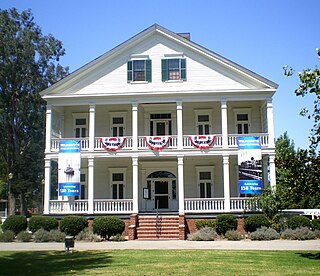
Banning House, also known as the General Phineas Banning Residence Museum, is a historic Greek Revival-Victorian home in the Wilmington section of Los Angeles, California. Built in 1863 by Phineas Banning near the original San Pedro Bay, it remained in the Banning family until 1925 and has been owned by the City of Los Angeles since 1927. The home, barn and gardens are now operated as a museum. The Banning House property, also known as Banning Park, has been designated as a city Los Angeles Historic-Cultural Monument and state California Historical Landmark and has been federally listed on the National Register of Historic Places.

Harbor City is a highly diverse neighborhood in the South Bay and Harbor region of Los Angeles, California, with a population upward of 36,000 people. Originally part of the Rancho San Pedro Spanish land grant, the 2.58-square-mile (6.7 km2) Harbor City was brought into Los Angeles as a preliminary step in the larger city's consolidation with the port cities of Wilmington and San Pedro.
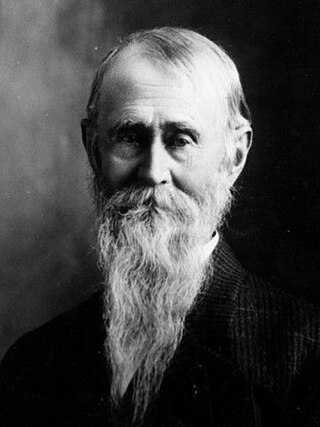
Henry Dwight Barrows was an American teacher, businessman, farmer, goldminer, reporter, United States Marshal, Los Angeles County School Superintendent, manufacturer, writer, and a founder and president of the Historical Society of Southern California.
Henry R. Myles was a physician who migrated to Los Angeles, California, soon after the city became a state following the Mexican–American War. He was elected to the Los Angeles Common Council, the governing body of the city, in a special election on September 6, 1853, for a term that ended May 4, 1854.
William Taylor Barnes Sanford (1814–1863) was an American road builder, a landowner and the second postmaster of Los Angeles, California, after it became a part of the United States. He was a member of the Los Angeles Common Council in 1853–54.

The Los Angeles & San Pedro Railroad was Southern California's first railroad. Its 21-mile (34 km) line from San Pedro Bay to Los Angeles was built from 1868 to 1869 and began operations on October 26, 1869. The railroad was the brainchild of Phineas Banning and its primary purpose was to transport freight from the port to the city.

Captain Phineas Banning Blanchard (1879–1962) was a tall ship sea captain, among the last of the American merchant trade in the age of sail.

Senator was a wooden, side-wheel steamship built in New York in 1848. She was one of the first steamships on the California coast and arguably one of the most commercially successful, arriving in San Francisco at the height of the California gold rush. She was the first ocean-going steamer to sail up the Sacramento River to reach the new gold fields. After more purpose-built river steamers became available, Senator began a 26-year long career sailing between San Francisco and Southern California ports. Age and improving technology finally made the ship unsuitable for passenger service by 1882. Her machinery was removed and she was converted into a coal hulk. She ended her days in New Zealand, where she was broken up sometime around 1912.

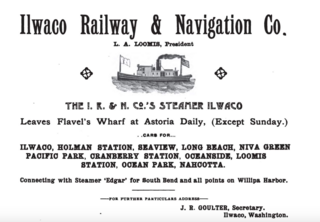
Ilwaco was a small riverine and coastal steamship built in 1890 which was operated as a passenger vessel for the Ilwaco Railway and Navigation Company, and later served in other roles, including tow and freight boat, cannery tender and fish packing vessel. Ilwaco was originally named Suomi.

Naval Base San Pedro and San Pedro Submarine Base were United States Navy bases at the Port of San Pedro, California officially founded in 1919. While commissioned in 1919, the Navy started operating out of the port in 1910, by renting dock space at the City of San Pedro's Dock No. 1 in 1914. The Navy had vessels stationed at the port starting in 1913. The San Pedro Submarine Base closed in 1923, with the end of World War I. Naval Base San Pedro became part of Naval Operating Base Terminal Island on 25 September 1941, which closed in 1947.





